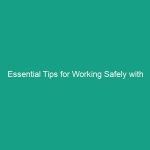Good Morning Team!
Today, we’re going to discuss a crucial aspect of our Workplace Safety: the essential S.O.R.T tool guidelines. It’s vital to understand how these guidelines can help us avoid critical Safety risks that could lead to serious accidents or injuries. So, let’s dive into why this topic is important and how it affects all of us in our daily operations.
Understanding S.O.R.T Tool Guidelines
The S.O.R.T acronym stands for Safety, Organization, Risk assessment, and Training. Each component plays a significant role in ensuring that our work Environment remains safe and efficient. Understanding these guidelines helps us not only comply with safety Regulations but also fosters a culture of safety within the workplace.
Common misconceptions include thinking that safety protocols are overly burdensome or unnecessary. However, these guidelines are designed to protect us and ensure that we can perform our jobs effectively without compromising our health and safety.
Key Hazards, Risks, and Safety Considerations
Ignoring S.O.R.T tool guidelines can lead to a range of Hazards, including:
- Improper tool usage: Using tools without proper training can result in accidents.
- Disorganization: A cluttered workspace increases the risk of trips and falls.
- Inadequate risk assessment: Failing to evaluate potential hazards can lead to severe injuries.
- Lack of training: Untrained employees are more likely to make mistakes that can jeopardize safety.
For instance, a worker who uses a power tool without understanding its Operation may cause not only personal injury but also endanger coworkers. The consequences of neglecting these safety protocols can be dire, leading to accidents that could have been easily preventable.
Best Practices, Procedures, & Actionable Advice
Here are some practical steps to help you adhere to S.O.R.T tool guidelines effectively:
1. Safety
Always wear appropriate Personal Protective Equipment (PPE) when using tools. This includes gloves, goggles, and hard hats depending on the task at hand.
2. Organization
Keep your workspace organized. Store tools in designated areas and ensure that walkways are clear. A clean environment minimizes risks significantly.
3. Risk Assessment
Before starting any task, assess the risks involved. Ask yourself:
- What could go wrong?
- What Safety Measures are in place?
4. Training
Participate in all training sessions provided by the company. If you feel uncertain about a tool or procedure, do not hesitate to ask for help. Remember, it’s better to ask than to risk an accident.
Case Studies
Let’s look at a brief example to illustrate these points:
Case Study: The Importance of Training
A construction worker was injured when using a power saw incorrectly. The worker had not attended the training session on the saw, believing it was straightforward to use. This incident could have been avoided had the worker adhered to the S.O.R.T guidelines, particularly the training aspect.
Regulations, Standards, and Compliance
It’s essential to be aware of the relevant safety Standards and regulations, such as OSHA guidelines and company-specific safety policies. Compliance with these regulations is not just a legal obligation; it’s a commitment to your safety and the safety of your colleagues.
Understanding these regulations helps us create a safer workplace. Always keep up to date with any changes in safety protocols and ensure that you are following the latest guidelines.
Employee Engagement & Discussion
Let’s open the floor for discussion. What safety challenges have you encountered related to S.O.R.T guidelines? Have you seen situations that could have been handled better? Sharing your experiences helps us all learn and improve our safety practices.
Conclusion & Key Takeaways
In summary, the essential S.O.R.T tool guidelines are vital for maintaining a safe and efficient workplace. Remember to prioritize:
- Safety: Always wear your PPE.
- Organization: Keep your workspace tidy.
- Risk Assessment: Evaluate potential hazards before starting any task.
- Training: Participate in training and ask questions when in doubt.
By applying these practices, we can significantly reduce the risks associated with our tasks. Thank you for your attention and dedication to maintaining a safe work environment. Let’s make safety our top priority every day!


